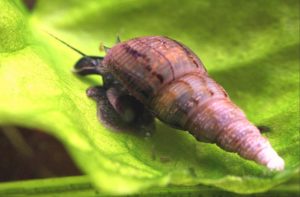12 May Aquarium Parasites, detection and elimination
The parasites are external living organisms brought into the aquarium, usually when we insert new plants or new fish. Initially, they are not a problem because they are innoqued and in small numbers, but reproducing can become weeds and damaging and if the number increases it could cause damage to plants and vegetation. To learn about the methods of elimination, we see the most common species: Planorbis, Physa, Melanoides, Acroloxus, while the parasites that eat meat are Planarians and Nematodes.
MELANOIDES SNAIL:
They are spirals with conical elongated shell with operculum, they do not feed plants but debris.
PHISA SNAIL:
It is a very varied snail type, it can be colored or dark brown, has a very fragile and short cone shell.
PLANORBIS PLANORBARIUS SNAILS:
It is flat shape shell, fragile with no operculum, has a very beautiful colorful appearance and feeds on algae, so it is also marketed, but be aware of its proliferation as it will reach a large number because instead to have a positive effect of decreasing the algae (delicious food for it) we will have a negative effect as it will start eating the plants.
ACROLOXUS SNAIL:
It has a delicate and shapely transparent shell, it is small in size and increases in number depending on the food available in the tank.
PLANARIA AND NEMATODES:

They are small white worms, fairly innoquate, they are meat feeder and live in less oxygenated areas such as not well ventilated, filter, or CO2 diffusers.
The methods we recommend to eliminate these types of parasites can be divided into 3 types: MECHANICAL METHOD, BIOLOGICAL METHOD, CHEMICAL METHOD.
MECHANICAL METHOD: It involves physical elimination directly from the furnishings, from the plants or from the bottom, by hand or with the help of special instruments such as pliers or better yet with specific traps,  consisting of blades inside. After trapping the parasites, you can easily extract them and re-enter the empty traps in the aquarium.
consisting of blades inside. After trapping the parasites, you can easily extract them and re-enter the empty traps in the aquarium.  Another “DIY” is to tie the bait to a wire (in the case of snails, vegetables such as lettuce or zucchini, in the case of nematodes or planaria pieces of meat) and remove it manually when parasites ar on to feeding.
Another “DIY” is to tie the bait to a wire (in the case of snails, vegetables such as lettuce or zucchini, in the case of nematodes or planaria pieces of meat) and remove it manually when parasites ar on to feeding.
 BIOLOGICAL METHOD: It involves the introduction of aquatic species of fish such as Botia for shellfish spiral cycles, or Betta Splendens and Macropodus Opercularis for planaria and nematodes. It is a very effective and natural method but this will increase the number of subjects in the tank, maybe that is not well received for other fish, without considering the growth of biological load on the biosystem.
BIOLOGICAL METHOD: It involves the introduction of aquatic species of fish such as Botia for shellfish spiral cycles, or Betta Splendens and Macropodus Opercularis for planaria and nematodes. It is a very effective and natural method but this will increase the number of subjects in the tank, maybe that is not well received for other fish, without considering the growth of biological load on the biosystem.
 The most effective biological method is the use of Killer snails called the “Anetome Helena” or hornet snail, a carnivore and cannibal gasteropode that feeds on other snails. It is a good compromise becaouse it will not be reproduced easily and in a 100 liter aquarium it will be enough for 3 specimens.
The most effective biological method is the use of Killer snails called the “Anetome Helena” or hornet snail, a carnivore and cannibal gasteropode that feeds on other snails. It is a good compromise becaouse it will not be reproduced easily and in a 100 liter aquarium it will be enough for 3 specimens.
CHEMICAL METHOD: provide the immition in to the aquarium of special chemicals product which, for their toxicity, will kill the various types of parasites. For Aquascaping Lab is obviously not recommended method, becauose is poisonous, it will also harm other living things or plants. Also after the desired effect, we will always have the product in the tank that will have to be removed with change of water and active carbonl in the filters. To conclude, all the corpses of the dead parasites will have to be removed for not to increase nitrites and nitrates or putrescents.



 English
English Italiano
Italiano